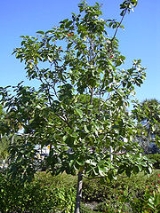
Geiger tree
Encyclopedia
Cordia sebestena is a species of flowering plant
in the borage
family, Boraginaceae
.
It is native to the American
tropics, from southern Florida
in the United States
and The Bahamas
southwards throughout Central America
and the Greater Antilles
. It is known as: siricote or kopté (Mayan) in 19th Century northern Yucatan; scarlet cordia in Jamaica; Geiger Tree (after Key West
wrecker
John Geiger) in Florida.
in garden
s because of its flower
s. It has dark green, oval shaped leaves
, and grows oval shaped fruit
s that are edible, but not flavorful. Cordia sebestena tolerates drought but not frost.
Flowering plant
The flowering plants , also known as Angiospermae or Magnoliophyta, are the most diverse group of land plants. Angiosperms are seed-producing plants like the gymnosperms and can be distinguished from the gymnosperms by a series of synapomorphies...
in the borage
Borage
Borage, , also known as a starflower, is an annual herb originating in Syria, but naturalized throughout the Mediterranean region, as well as Asia Minor, Europe, North Africa, and South America. It grows to a height of , and is bristly or hairy all over the stems and leaves; the leaves are...
family, Boraginaceae
Boraginaceae
Boraginaceae, the Borage or Forget-me-not family, include a variety of shrubs, trees, and herbs, totaling about 2,000 species in 146 genera found worldwide.A number of familiar plants belong to this family....
.
It is native to the American
Americas
The Americas, or America , are lands in the Western hemisphere, also known as the New World. In English, the plural form the Americas is often used to refer to the landmasses of North America and South America with their associated islands and regions, while the singular form America is primarily...
tropics, from southern Florida
Florida
Florida is a state in the southeastern United States, located on the nation's Atlantic and Gulf coasts. It is bordered to the west by the Gulf of Mexico, to the north by Alabama and Georgia and to the east by the Atlantic Ocean. With a population of 18,801,310 as measured by the 2010 census, it...
in the United States
United States
The United States of America is a federal constitutional republic comprising fifty states and a federal district...
and The Bahamas
The Bahamas
The Bahamas , officially the Commonwealth of the Bahamas, is a nation consisting of 29 islands, 661 cays, and 2,387 islets . It is located in the Atlantic Ocean north of Cuba and Hispaniola , northwest of the Turks and Caicos Islands, and southeast of the United States...
southwards throughout Central America
Central America
Central America is the central geographic region of the Americas. It is the southernmost, isthmian portion of the North American continent, which connects with South America on the southeast. When considered part of the unified continental model, it is considered a subcontinent...
and the Greater Antilles
Greater Antilles
The Greater Antilles are one of three island groups in the Caribbean. Comprising Cuba, Jamaica, Hispaniola , and Puerto Rico, the Greater Antilles constitute almost 90% of the land mass of the entire West Indies.-Greater Antilles in context :The islands of the Caribbean Sea, collectively known as...
. It is known as: siricote or kopté (Mayan) in 19th Century northern Yucatan; scarlet cordia in Jamaica; Geiger Tree (after Key West
Key West
Key West is an island in the Straits of Florida on the North American continent at the southernmost tip of the Florida Keys. Key West is home to the southernmost point in the Continental United States; the island is about from Cuba....
wrecker
Wrecking (shipwreck)
Wrecking is the practice of taking valuables from a shipwreck which has foundered near or close to shore. Often an unregulated activity of opportunity in coastal communities, wrecking has been subjected to increasing regulation and evolved into what is now known as marine salvage...
John Geiger) in Florida.
Cultivation
Cordia sebestena is widely planted throughout the tropics and subtropics as an Ornamental plantOrnamental plant
Ornamental plants are plants that are grown for decorative purposes in gardens and landscape design projects, as house plants, for cut flowers and specimen display...
in garden
Garden
A garden is a planned space, usually outdoors, set aside for the display, cultivation, and enjoyment of plants and other forms of nature. The garden can incorporate both natural and man-made materials. The most common form today is known as a residential garden, but the term garden has...
s because of its flower
Flower
A flower, sometimes known as a bloom or blossom, is the reproductive structure found in flowering plants . The biological function of a flower is to effect reproduction, usually by providing a mechanism for the union of sperm with eggs...
s. It has dark green, oval shaped leaves
Leaf
A leaf is an organ of a vascular plant, as defined in botanical terms, and in particular in plant morphology. Foliage is a mass noun that refers to leaves as a feature of plants....
, and grows oval shaped fruit
Fruit
In broad terms, a fruit is a structure of a plant that contains its seeds.The term has different meanings dependent on context. In non-technical usage, such as food preparation, fruit normally means the fleshy seed-associated structures of certain plants that are sweet and edible in the raw state,...
s that are edible, but not flavorful. Cordia sebestena tolerates drought but not frost.

